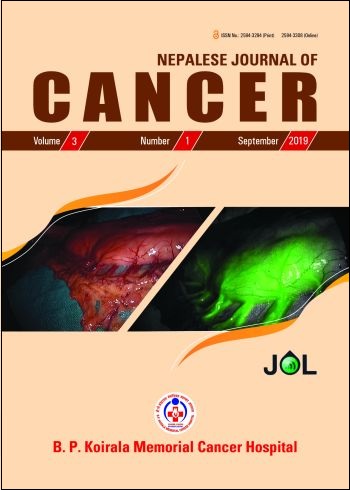Comparative Study of Treatment Response and Toxicity of Four Field Box Technique Versus Two Field Technique External Beam Radiotherapy in Locally Advanced Carcinoma Cervix
DOI:
https://doi.org/10.3126/njc.v3i1.25912Keywords:
External Beam Radiotherapy, concurrent chemotherapy, locally advanced cervical cancerAbstract
Introduction: External beam radiotherapy plays a pivotal role in locally advanced carcinoma cervix. EBRT treats the whole pelvis including the primary tumor along with the regional lymph nodes. Conventionally, EBRT planning is based on standard bony landmarks using X-rays and can be delivered by anterior–posterior and posterior–anterior (AP-PA) parallel opposed fields or the four field box technique. AP-PA field technique provides good coverage to the target volume. Four field box technique with parallel opposed AP-PA fields and two lateral opposed fields although has better dose distribution and decrease normal tissue toxicity, is time consuming. EBRT by AP-PA two field technique is generally used in our center due to less manpower and resources and huge load of patients. But, pelvic radiotherapy by 4 field portals has been proven by the trials that it has better tumor response. So, the objective of this study was to compare the tumor response and acute hematological and non- hematological toxicities between the two techniques.
Methods: One hundred and twenty patients with diagnosis of carcinoma cervix were enrolled in this study, sixty assigned in each group. Group A received radiation by AP-PA two field technique and Group B by 4 field box technique. Chemotherapy regimen was the same for the two groups. Treatment response and toxicities were evaluated after the completion of treatment and compared between two groups.
Results: All enrolled patients received planned treatment. The total duration of treatment in both the groups was 23 days. Loco-regional control with complete remission was 63.3 % in group A Vs. 73.3% in group B (p= 0.405). Acute toxicities of grade 1 and grade 2 were seen more in group A compared to group B, nausea (63.3% vs. 56.7% p=0.141), vomiting (13.3% vs. 20% p=0.234), diarrhea (10% vs. 6.7%), radiation dermatitis (3.3% vs. 0%). Hematological toxicities like anemia, thrombocytopenia and leucopenia were observed more ingroup A than group B.
Conclusion: Both two and four field box techniques are equally effective and feasible as statistically insignificant difference in the response rate and acute toxicities was observed in the two groups.
Downloads
Downloads
Published
How to Cite
Issue
Section
License
This license lets others distribute, remix, tweak, and build upon your work, even commercially, as long as NJC and the authors are acknowledged.
Submission of the manuscript means that the authors agree to assign exclusive copyright to NJC. The aim of NJC is to increase the visibility and ease of use of open access scientific and scholarly articles thereby promoting their increased usage and impact.




